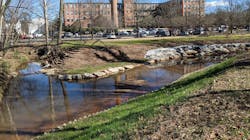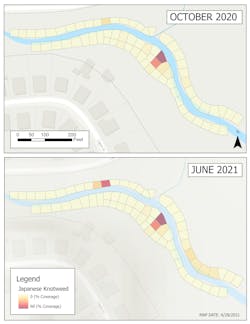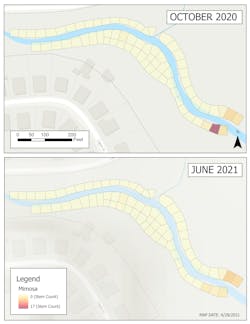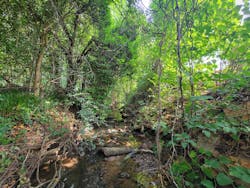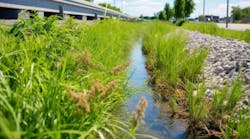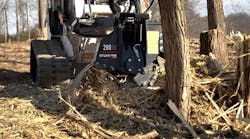Can you identify the non-native plants in your community? If the answer is "no," invasive plant species may be threatening your city's natural ecosystem.
Invasive species can be found in gardens, suburbs and forests, often planted for their beauty or spread by seed. Invasive plants are also sometimes available for purchase at local nurseries, big box stores and wholesale suppliers, although this is changing as researchers identify the negative impacts these species can have on native ecosystems. In fact, invasives can be so harmful that some states have banned their sale. One well-known example of this is kudzu. This non-native plant was historically used to provide cover and stabilization in hopes of reducing erosion of bare soil. Kudzu not only failed to stop the erosion, but it also took over areas with ample sunlight, climbing up trees and native vegetation toward the sun. With its ability to grow up to one foot per day, kudzu can quickly overtake fields and trees, eventually blocking any native vegetation from sunlight and out-competing them for nutrients. Some states have gone so far as to make kudzu illegal to grow.
"We're seeing the negative side effects of some of these invasive plants," said J.P. Johns, water market director at Woolpert. "In wetland areas, in particular, certain invasives don't support the ecosystem. People are realizing that these non-native invasive plants that have been established, whether by mistake or on purpose, are causing negative impacts in their communities."
The United States Environmental Protection Agency has identified the consequences of invasive species. The projected damages are estimated to be as high as $138 billion annually. Those damages impact rangeland, food supplies, homes, yards, outdoor recreation, human and animal health, fishing, boating, rivers, forests, agriculture and water quality. It has also been reported that 42% of endangered or threatened species are at risk because of invasives.
"We're losing some of our historical native plants that were here 100 years ago," Johns said. "These native plants were great at supporting the ecosystem, but now they're being replaced by more competitive invasive plants."
Given the consequences, officials in Greenville County, South Carolina want to reduce the presence of non-native invasive plants. The county is starting by targeting invasive species along its streams during stream stabilization projects.
Decreasing the Impact in Greenville County
By removing invasive plants around its streams, Greenville County hopes to regain essential resources to improve water quality.
"Communities are beginning to recognize streams as assets to be protected instead of a nuisance,” said Crystal Muller, project manager and engineer at Woolpert. "Streams are a primary form of conveyance for stormwater runoff, and if you allow them to degrade over time, banks fail and streams widen, leading to higher amounts of sediment in streams and property loss. This sediment and associated pollutants contribute to many of the impairments we see today."
The Reedy River, a 65-mile-long tributary of Saluda River, runs through Greenville County and has been the subject of regulatory and stakeholder attention since an algal bloom occurred in Lake Greenwood in 1999. Today, it is one of only three watersheds in all of South Carolina impaired for nutrients like nitrogen and phosphorous.
“The pervasive nature of invasive vegetation and its qualities are in opposition to the county’s long-term water quality goals for the Reedy River,” said Judy Wortkoetter, PE, county engineer for Greenville County. “Many of the most pervasive invasive vegetations spread extremely fast, have shallow root systems, and do not uptake as many nutrients, making the areas where they are established less resilient to change and more likely to degrade over time.”
“Instead of allowing streams to contribute to these challenges, Greenville County is trying to re-establish native plants to get streams back to their original function,” Muller said.
This approach will ensure streams aren’t contributing to poor water quality but rather helping fix the issue. With a healthy establishment of native vegetation along streams, streams can act as filters by removing nutrients and contaminants from the water.
“Stream restoration has proven to be an effective and aesthetic tool in reducing pollutant loading in watersheds around the country,” Wortkoetter said. “It repairs and prevents future bank failures, lowers erosive forces by increasing access to flood plains and benches and establishes a resilient native vegetation community that can play a significant role in nutrient reduction.”
With Greenville County taking steps to restore its streams, the intended result is decreased pollution in the Reedy River making it usable and safe to enjoy.
Reducing the Presence of Invasive Plants
In 2020, Greenville County contracted Woolpert for a 1,000-foot streambank restoration project along Brushy Creek. One objective of the project was to plant and establish native vegetation. Another was to reduce the prevalence of invasive species to ensure the long-term viability of restoration efforts. For the latter goal, a grid system was used to assess both banks of Brushy Creek and identify the most concerning invasives. After the analysis, Greenville County discovered that the following non-native invasive plants were the most problematic along the studied corridor: leatherleaf mahonia, Chinese privet, mimosa tree, English ivy and Japanese knotweed.
Under the supervision of Woolpert, the selected invasive species were treated by a licensed herbicide applicator, who employed both mechanical and herbicidal methods. Basal bark treatments were used on the invasive woody species by manually cutting stems and applying a very direct spray of herbicide. For non-woody invasive species, handheld spray bottles were used to deliver a light mist directly to the foliage. Greenville County preferred this approach, as it limited overspray onto the newly planted native vegetation and into Brushy Creek. It was important that the chosen herbicides proved effective while limiting environmental impact.
"One of the solutions used was a targeted herbicide that treats for woody species like mimosa tree, Chinese privet and leatherleaf mahonia," said Maria Akridge, a former field technician at Woolpert who's now a stormwater inspector for Anderson County, South Carolina.
However, due to the hollow, bamboo-like stem of the Japanese knotweed, a more targeted herbicide would not be effective, which only added to the difficulty of control.
"For Japanese knotweed, the licensed herbicide applicator had to use a foliar herbicide that must be sprayed on the leaves of the invasive for it to be effective," Akridge said.
One year later, another grid assessment was performed to see if the invasive plant species were less prevalent along Brushy Creek. During the analysis, Greenville County discovered a significant reduction in most invasive plants but noticed that Japanese knotweed had continued to spread aggressively.
Japanese knotweed is a prolific seed producer that also spreads through rhizomes. For officials, this meant multiple treatments with a focus on timing would be necessary to manage the invasive vegetation. Knowing this, Greenville County shifted the primary focus to Japanese knotweed to reduce the number of plants and seeds dropped.
"Japanese knotweed grows underground and springs up through rhizomes, so it's very aggressive, which is why those follow-up treatments were necessary. It’s similar to bamboo, but it seeds annually," Akridge said.
After multiple treatments by a licensed herbicide applicator, a visual survey confirmed that the aggressive efforts to greatly reduce the invasive plant along the Brushy Creek project length were effective.
“This management provides the native species planted along stream restorations and elsewhere with the head start needed to outcompete invasive species and thrive,” Wortkoetter said. “And a thriving community of native vegetation is the best defense against future invasive vegetation establishment.”
Shifting the Focus Upstream
For officials to successfully establish native vegetation and control invasive species along the project length, a survey was done approximately 1,500 feet up Brushy Creek and 1,500 feet up a small tributary from the project site. The assessment revealed various non-native invasive plants upstream, including multiple stems of mimosa trees, dense pockets of Japanese knotweed and a small patch of kudzu.
Greenville County is currently considering different approaches to treat each invasive plant species. For Japanese knotweed, well-timed foliar sprays have proven effective. A similar method is likely to be effective with kudzu, although unconventional methods, such as goat grazing, have also been considered. Basal bark treatment methods have proven effective for mimosa tree and other woody invasive species, but the focus of the treatment for these invasive plants would center on controlling small stems adjacent to the streambank so that seeds are not carried downstream. The challenge now is access. These upstream areas are on private land, so performing these critical tasks requires property owners’ consent.
However, now that Greenville County has established native vegetation along the stream reach and managed to minimize the prevalence of invasive plants, the project section of Brushy Creek will no longer act as a source of but a filter for nutrients, enhancing water quality in the Reedy River instead of contributing to the pollution. Controlling invasives upstream will only further help to ensure that these efforts aren’t undone.
Controlling Invasives is Possible
Other municipalities that have noticed the consequences of non-native invasive plants in their communities can take steps similar to those of Greenville County. When discussing specific strategies, Johns believes a great place to start is by restoring streams that could have the most positive impact on water quality.
"While every flowing stream is important for municipalities to maintain to the best of their abilities, that's not always feasible," Johns admitted. "Instead, municipalities should focus on treating hot spots. They should identify streams overrun by invasives and impaired by nutrients and find sections where control efforts will provide the largest beneficial impact and where the community has the access and ability to provide necessary follow-up efforts.”
Johns also believes officials can manage the impact of invasives by taking preventative steps and educating themselves and their residents on what the natural environments should look like in their communities. Efforts to limit the influx of potentially harmful species might include regulating the sale of invasives or requesting that certain species not be sold at local nurseries and big box stores. Desirable alternative native plants that offer the same or similar aesthetics at comparable price points should be provided to further encourage the establishment of native species. At the very least, perhaps non-native invasive plants could be clearly labeled as such.
"It's important to evaluate whether non-native plants should be sold in certain areas," Johns said. "Officials should inform citizens to consider the potential negative impacts and how difficult or costly it would be to control the adverse effects.”
The consequences of not prioritizing education could lead to invasive species not only outcompeting native plants but taking over entire stream corridors and fields. This is the case with Bradford pear trees, plants native to Asia known for their stately appearance and white blooms. Because they bloom early in the year, these trees absorb natural resources before native species that bloom later. Consequently, there are now multiple fields of Bradford trees in Indiana. State officials are working to educate residents and nurseries about this plant's negative effects on the ecosystem. South Carolina is taking that effort one step further—by Oct. 1, 2024, nurseries in the state will no longer be permitted to sell the species.
Johns described the impact of invasives taking over at such a significant level: "If our native vegetation community is replaced by non-native invasive plants, our ecosystems can fail to thrive, impacting our local flora and fauna.”
While Johns understands complete eradication of invasive plant species may not be possible or even feasible, the spread of non-native plants is controllable when education and targeted treatment are communities’ primary strategies. Greenville County is especially committed to using the latter strategy as a part of its stream stabilization projects.
“Greenville County will continue to perform invasive management for future projects,” Wortkoetter said. “Lessons learned on Brushy Creek have already proven useful elsewhere, like at Shoeless Joe Jackson Park, where pre-treatment of invasive vegetation three to six months prior to a park re-development greatly reduced the level of effort required later.”
As these initiatives continue, officials in Greenville County will also prioritize education to ensure community members are aware of the impact of invasive plants.
“Greenville County works with the Soil and Water Conservation District to support programming that encourages the use of native vegetation,” Wortkoetter said. “The funding of educational signage along stream corridors and greenways will also help educate the public about these issues.”
Woolpert Engineer Phase Manager Zach Smoot works out of Woolpert’s Greenville, S.C. office, alongside Woolpert Environmental Scientist Shady Agnew.
